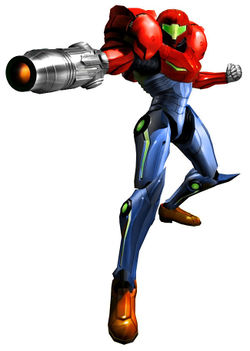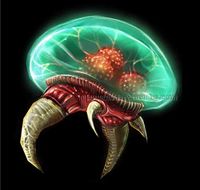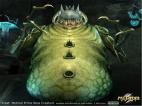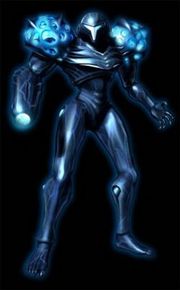Metroid
| Warning. This Article contains the spoiler that Samus is a girl. ...So, if you don't want to find out that Samus is a girl, which she is, don't read it. ...Because Samus is a girl |
| Metroid | |
|---|---|
 Given the success of the Metroid Prime games in particular, some have suggested that Samus Aran should be Nintendo's new mascot. | |
| Developer(s) | Nintendo Retro Studios Team Ninja |
| Publisher(s) | Nintendo |
| Platform(s) | Every Nintendo system except the Nintendo 64, Virtual Boy and Wii U |
| Platform of origin | NES |
| Release | 1986 |
| Genre | Action Adventure Platforming First-person shooter Third-person shooter Pinball Zombie apocalypse simulator Striptease |
| Rating | High for the Metroid Prime series, but declining since Metroid: Other M |
| Official website | https://www.halowaypoint.com/ |
Metroid is one of the many video game franchises to be created by Nintendo. It involves a bounty-hunter-space-pirate-killing-galactic-federation-helping-metroid-hunting woman named Samus Aran. Boss.
Gameplay[edit | edit source]
Metroid immerses gamers in a hyper-realistic world of jumping, shooting, and exploring really creepy dungeons in outer space. Gameplay involves backtracking through surreal levels, followed by more backtracking, and even more, all the while fighting off bizarre monsters that apparently have nothing better to do than crawl/fly around in the same preordained pattern for eternity.
There's also a very annoying pattern where you start the game off in what seems like it could be a suit of total win, but one slight bump causes you to lose every single ability. Thankfully, this is mostly present in the Prime series, which even fewer people play than the other ones. You must then spend 50+ hours recovering said abilities, so that you can use three of them on the final boss.
Metroid is in no way similar to any other games, perhaps being one of the most immerse and creative games out there. For instance, it has been widely acclaimed for letting gamers roll into a ball, thereby getting to live out their latent fantasies of being a hedgehog. It is also known for it's shooting from the arm-cannon feature, not to mention the ability to charge up blasts, among hundreds of other upgrades.
Recently, the series has abandoned the rolling, jumping, shooting, and mass genocide approach to gaming and gone decisively into hardcore sex, raising concern and ire from various U.S. politicians who have nothing better to do.
Main characters[edit | edit source]
- Samus Aran (Charlize Theron) – Also known as "Metroid" by people who've never played the games. She is the main protagonist of the Metroid series, a human-Chozo-Metroid-X-parasite-Phazon hybrid. Despite being the "protagonist", Samus is seen engaging in systematic desecration of religious sites, widespread genocide, destruction of indigenous species, and other loathsome crimes, and apparently getting paid to do so. Nobody knows why she was let out of the kitchen, but some argue she was let out because she can kick your ass. She also has time to clip her eyebrows and keep her hair in a huge ponytail underneath her helmet, like some sort of turban. In the early years of the franchise, her gender was not a huge selling point, but things took a drastic turn ever since Metroid: Zero Mission and its introduction of the skin-tight Zero Suit, a now essential component in recent Metroid games and the various fan works.
- Ridley (Frank Welker) – A huge dragon who Samus fights at least once every game because he has no friends, appearing often for no real reason other than to wreck everything and trigger the self-destruct sequence of whatever area you happen to be fighting in. He is the leader of the Space Pirates and responsible for the destruction of Samus's home colony, not even leaving her a kitchen to be in. In Other M, he starts off as a Furby, but later evolves and scares the living shit out of Samus.
- Space Pirates (Bill Faggerbakke) – The main race of antagonists in the Metroid series, the Space Pirates are notorious for being amongst the dumbest videogame characters ever created. Their sole purpose in the games seems to be to build their bases in such a way that makes it as easy as possible for Samus to get through. Their efforts towards this goal include installing doors that open only after being hit with certain beams, installing map, ammo, and health dispensers that can only be accessed via a cannon arm, and connecting all of the rooms through an enormous series of morphball-sized tubes. While the Space Pirates themselves have no apparent means of using any of this, Samus can use all of it, nicely allowing her to continually destroy all of their shit... again and again and again. You'd think they'd eventually learn.
List of games[edit | edit source]

Here is a complete list of all the games released in the series so far. Nintendo may release more if it can be determined that the cash cow still has milk left in it.
Metroid (NES)[edit | edit source]
The first game in the Metroid series, released in 1986 to compete with Pong. The plot revolves around Samus Aran, who decides to visit the planet Zebes to destroy various alien creatures simply minding their own business, the metroids, Mother Brain, and the finally the whole planet, in that exact order. She also assassinates Kraid and Ridley along the way, because they owed her money for previous bounty hunting missions.
The game tanked on retail shelves, once people realized it had terrible graphics, tinny music and sound effects, sloppy controls, and uninspired level design featuring miles of repeated tunnel sections and hiding upgrades inside walls as a gimmick. It was also full of glitches, probably because the programmers lazily copied the code for Kid Icarus and just changed the sprites. The game series should have died right then and there. However, the deep and intriguing plot created a cult following, leading some gamers to beg Nintendo afterwards for a new 2D Halo clone like the original.
Metroid single-handedly emasculated an entire generation of gamers by showing them at the end of the game that the cool space bounty hunter guy they were playing as was actually a sexy woman.
Metroid II: The Return of Samus[edit | edit source]
The second game in the Metroid series, released on the Game Boy in 1991 to commemorate the fall of the Berlin Wall. In this game, Samus is asked by the future United States government to travel to planet SR388 and wipe out all the metroids there to eliminate any remaining traces of the Soviet Union. After she kills the Queen Metroid (revealed to be the reincarnation of Vladimir Lenin), she finds one last baby Metroid, which hatches before her and is promptly adopted.
Metroid II sold poorly, even worse than the first game on the NES. It shared all of the same design flaws and even more copied Kid Icarus code, but was now also in black and white in order to save money on artwork. However, the cult following for Metroid continued to grow.
Super Metroid[edit | edit source]
Released in 1994 for the Super Nintendo. Samus drops off the baby Metroid at a research station after realizing she couldn't afford canned food for it. However, Ridley steals the Metroid, and Samus chases him back to Zebes, since he apparently still owed her money. Once there, the game becomes an exact replica of the original Metroid game, except with something finally resembling decent graphics. The baby Metroid begins tentacle-raping Samus before Mother Brain saves her, which Samus repays in kind via rainbow lasers to the eye. Zebes blows up (again) and Samus flies off to go on vacation.
The mainstream gaming market briefly took notice, but by this point not even the fact that a brand-new game engine containing no Kid Icarus code could save the series from its struggling sales. The Nintendo 64 came around, and Nintendo decided to shelve the series until nobody could remember how terrible it was.
Metroid Prime[edit | edit source]
After the dawn of the new millennium, the combined prayers of the Metroid cultists had finally been realized. Nintendo gave the little-missed series a reboot in the Prime series. In the first Metroid Prime, Samus tracks down Ridley again to the planet Tallon IV (not that he still owed her any money; she just hated him by now). While there, Samus explores a interactive museum of alien natural history, and also kills some more space pirates. She kills Ridley again, and defeats Metroid Prime itself.
Gamers showed massive interest in this entry into the series, because they wanted to see Samus' boobs in 3D at long last. However, she only takes off her helmet at the end of the game, leading some to accuse Nintendo of false advertising in order to drive up sales. Metroid Prime could also be seen as Nintendo's attempt to cash in on the first-person shooter fad started by Halo, which this game was a near-complete copy of. Nevertheless, Metroid was now earning Nintendo money, prompting the development of obligatory sequels and spinoffs. This game and Super Smash Bros. Melee were the only things keeping the GameCube console afloat.
Ever since Metroid Prime was released, Halo fans have accused the Metroid series of being a ripoff of their series. This is all despite the fact that Metroid started in 1986, fifteen years before Halo.
Metroid Fusion[edit | edit source]
Released at the same time as Metroid Prime so players could unlock a hideous extra suit in the former if they also bought a Game Boy Advance and special link cable. Taking place after Super Metroid, Samus gets an alien infection, but then is injected with Metroid cells, which somehow changes her DNA and lets her eat the infection. She then must go to a research station filled with infected creatures, where she regains her abilities, takes on a doppelganger and blows up the station, this time supposedly killing off (for real) the Metroids for good, which could have prevented the problem in the first place.
After having a taste of Metroid Prime, gamers simply couldn't be bothered to return to the 2D games, and Metroid Fusion did not sell well. No new 2D Metroid games have since been released by Nintendo.
Metroid Prime 2: Echoes[edit | edit source]
Using what they learned from trial and error up until this point, Nintendo finally understood that modern gamers wanted first-person shooters. Thus, they released Metroid Prime 2: Echoes, in which Samus thinks she is going to planet Aether to save some Federation troopers on a camping trip gone awry, but instead must take on a series of clichés. These include such staples as a light/dark world for twice the backtracking, an evil twin, and Samus losing all of her powerups yet again at the start of the game.
Metroid Prime Pinball[edit | edit source]
An unremarkable pinball game made for the Nintendo DS, despite the fact that it could have been implemented just as easily as an actual pinball table in an arcade somewhere and probably would have made more money. It was meant to be used with the Rumble Pak, which has since persuaded Nintendo to never again include an expansion or peripheral port on any future DS handhelds out of its sheer uselessness. For some reason, however, it proved to be quite popular with female gamers.
Reportedly this game was "too scary" for the majority of its 6 players.
Metroid Prime: Hunters[edit | edit source]
Another spinoff from the main Metroid Prime series. Samus must collect eight octoliths by fighting the same two bosses over and over, and also periodically promote feminism by defeating rival bounty hunters, all of which are male. The single-player mode somehow managed to suck worse than the 2D Metroid games, which is an incredible achievement on Nintendo's part and would not be topped until the release of Metroid: Other M later. The real draw is the multiplayer, which has the distinction of being the ultimate online glitchfest, with the winner being whoever is using a Game Shark or knows the most ways to hide inside walls. Few players were leet enough to remain by the time Nintendo finally shut down the DS online play servers, when it was as if a handful of voices cried out from their moms' basements, and were suddenly silenced.
Metroid: Zero Mission[edit | edit source]
A Game Boy Advance remake of the original Metroid for the NES, with the primary concern of crappy graphics better addressed. A few fans bought this game when they heard about the extra part added at the end where Zero Suit Samus is playable, but were disappointed that the pixelated 2D graphics still didn't provide them the boob jiggling they secretly hoped for. For the most part, this game has since faded into obscurity, as it brought nothing new to the series.
Metroid Prime 3: Corruption[edit | edit source]
Metroid fans were done with filler by now, so the third game installment released on the Wii. Dark Samus is recycled as the primary threat from Metroid Prime 2: Echoes, and three new bounty hunters were introduced in this game: one with the best music, one with the most forgettable music, and one which was a gymnastic lesbian constantly trying to rape Samus during her boss fight. They all get infected with some glowing blue chemical, which provided the art team the excuse they needed to overuse the color blue and bloom lighting effects. Samus finally finds the planet where the color blue comes from, then defeats Dark Samus and the Mother Brain ripoff she possesses once and for all.
By this point, many fans started to feel that the Metroid Prime series had gone stale, and Nintendo agreed. They needed a new game which would do better justice for the old 2D "classics", and they secretly set to work on their masterpiece.
Metroid: Other M[edit | edit source]
The critically-acclaimed game which many felt was the best Metroid title ever. Samus receives a distress call from the "Bottle Ship", which is yet another mismanaged biological research station. Upon arrival, she meets her father figure / lover Adam Malkovich, some token black guy who remembers Samus from a previous life, and an android with Mother Brain's programming and severe PMS. The secret connection between Ridley and Furbies is also revealed, further deepening the story.
Critics and fans alike praised the magnificently-written plot, which Nintendo brought William Shakespeare back from the dead for specifically to write on minimum wage and a tight deadline. Samus in particular was praised for finally being portrayed as a strong, compelling character with excellent voice acting. The gameplay, which constantly shifted between a 2.5D shooter and a "Where's Waldo?" first-person mode, was heralded as revolutionary. Given how hard this game was going to be to top, Nintendo is taking its time trying to come up with an even better sequel for the Nintendo 3DS.
Metroid Prime: Federation Force (in development)[edit | edit source]
The aforementioned cash cow did start to run out of milk, so Nintendo desperately mutated it with some leftover Phazon. According to the Space Pirate scientists overseeing the experiment, Nintendo is currently going all-out on making sure Metroid: Other M is not the series' most memorable moment. Nintendo's design goals for the upcoming title include combining the worst gameplay elements of all the previous titles, re-animating the multiplayer component, and adding some new abominations (and fewer aliens), then wrapping them all up in the artistically-creative style of a Nintendo 64 game in 3D. Metroid Prime: Federation Force will provide Nintendo 3DS owners the best excuse yet to stick to Super Smash Bros. 3DS, Pokémon X/Y or even Mii Plaza for their gaming enjoyment. Nintendo's R&D department is currently trying to figure out how they can compress even more shit into the memory space of a single 3DS game card, hoping to achieve maximum capacity before the game's slated release date of sometime in 2016.
History[edit | edit source]
Origins[edit | edit source]
Metroid was originally designed to train Japanese youths in the way of mass extermination of foolish Americans, but sold poorly in this category. In 1986, it was rebranded for the American market as a game that focused on the mindless destruction of a flying jellyfish that ate people's brains. This time, it was a rousing success.
Perhaps most of all, the main protagonist of the game Samus Aran, was a girl. It is rumored that she was intended to be the typical cocky male hero who attracts male gamers because they can imagine they are as jerk-ass as all that, but a courageous, computer geek female gamer (identity unknown) broke into Nintendo and changed the last scene so that Samus was a girl in the final credits. Nintendo, of course, didn't care that the reign of chauvinism in gaming was over—all they cared about was dancing dollar signs in their eyes.
The Sexy Secret of Metroid[edit | edit source]

Sensational international video game developer Nintendo raised some eyebrows (not to mention dropped some monocles from the more well-heeled amongst the international video-game community), when it included a crude scene of the star of the first Metroid title, Samus, doffing her armor and getting hot wax dripped on her by a lecherous metroid as a reward to the gamer for finishing the game in under ten seconds.
Titillated by both the 8-bit rendition of run-of-the-mill sexual sadism and the revelation that the ass-kicking, shooting/jumping hero they had been shooting with and rolling into balls as was, in reality, a woman (albeit an 8-bit woman) gamers everywhere developed an obsessive and irrational love for Metroid. These sexually-challenged trolls hoped, erroneously, that future games would include further glimpses of Sexy Samus, but would be disappointed for a very long time.
Nintendo, famous for listening to input from fans, quickly rushed out Virtual Boy into mass production, touting its "futuristic three-dimensional gameplay." Sadly, Virtual Boy did not include a Metroid title, and the platform was doomed from the get-go. When a Metroid title failed to appear on the wildly popular Super Nintendo 32X CD Master System, fanboys attacked Nintendo of America headquarters with homemade lightsabers, until they were escorted away by security.
Samus Is a Girl[edit | edit source]
Samus Aran was received well by the public, and was also the main reason that Nintendo decided to acknowledge female gamers, instead of just throwing them under the bus like they used to. It appears as though Nintendo received brain cells for a few seconds whilst the idea of Samus was conceived and decided to act on it, if only to have some fun staring at her chest during the animation times and using the excuse that, "They don't look right, dude. Maybe if I saw them without the Power Suit...".
Initially, Nintendo did not use Samus's gender as a selling point in advertisements. Admittedly, Samus did strip off her armor and display her body in swimsuits and underwear during the hard-to-obtain 100% bonus endings, but these events accounted for less than 1% of screen time. The player could only glimpse her true appearance for a few seconds before she vanished; the rest of the time, she was a badass bounty-hunter ripping through her enemies with blasts of energy.
However, by 2004, it seemed Nintendo wanted to appeal to the "horny weeaboo" demographic, and so they introduced the Zero Suit—a form-fitting, skintight bodysuit that hugs Samus's generously-proportioned curvy body—as a selling point of the new game, Metroid: Zero Mission.
Parents' Groups, Hillary Clinton and "Joltin' Joe" Lieberman React and Save the Childrens[edit | edit source]
With the 2004 release of Metroid: Zero Mission, Samus was transformed from a gender-neutral character into yet another generic sexualized anime girl for nerds to pleasure themselves to. Ever since Samus first strut around in the Zero Suit, there has been an outpouring of erotic fan art depicting her in all sorts of sexual situations and poses.
Washington finally took notice of what dateless losers across the world had known for 20 years: there was a woman under the armor, and she was a woman who needed at least three men at the same time to help her through "hard times."
Democratic Senator Joe Lieberman (Conn.), after playing the game for a week straight in his closed chambers, emerged looking rumpled, a bit sweaty and definitely shaken. Said Lieberman:
| “ | Truly, if this game is purchased by children, children will be treated to some of the roughest, stickiest, hardest digital sex commercially available, making such virtual sex standards as Virtual Vixen and Sexy Beach 2 look like Peek-a-boo Poker. This cannot happen, and I look forward to examining more Metroid titles in the future, so I can think of some good legislation to pass. For the childrens. | ” |
Parents groups, such as MAVVGASSIVGTNNBSG(Mothers Against Violent Video Games and Sexual Situations in Video Games Though Not Necessarily Both in the Same Game), when questioned about the possible negative effects of the sexiness epitomized by the Metroid series, started shrieking incoherently and banging on iron pots with wooden spoons to get their point across, though what their point was is unclear at this moment.
The death of Metroid[edit | edit source]
Upon the release of Metroid: Other M, fans were getting tired of ecchi Samus and anticipated the return of old Samus: the Queen Bitch. But they ended up with an oversensitive, overdramatic, whiny magical girl who let herself to be pushed around by her commanding officer. Instead of blowing up stuff and being cool, Samus did nothing but cry and spill her emotions.
For the first half of the 2010s, prospects of another Metroid game looked weary, due to the series not getting mentioned by Nintendo during its 15th anniversary. Then came E3 2015, when Nintendo announced Metroid Prime: Federation Force. The fanboys' cheers of joy quickly faded into stunned silence, as the game was not to feature Samus, but rather a bunch of Federation marine dudebros.
Despite not being released yet, the game instantly garnered the unbridled nerd rage of a thousand screaming virgins. A Google search for "Metroid Prime: Federation Force" returns a Change.org petition to get Nintendo to "cancel the game" as one of the first results.
A series that used to be on top of the world has now been reduced to a laughingstock, just like Sonic the Hedgehog. Metroid is dead, unless the galaxy is invaded by the "other Metroid". Fans are recommended to "pray for a true peace in the [sic] space" (or Sylux's restraining order to expire in time for a fourth Metroid Prime installment).
See also[edit | edit source]
Reception[edit | edit source]
Metroid has been a very successful series until the release of Metroid: Other M, and an international video game sensation. Bungie attempted to cash in on the series' wild success with Halo, but it could not attain the same level of quality nor popularity.




